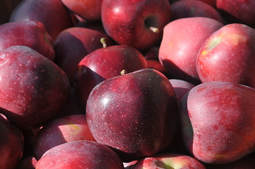 You can enjoy apples from January to June – with the right conditions. Some apple cultivars can be stored for longer periods than others. Some cultivars will stay in firm, crisp condition for about 6 to 8 months with good storage conditions. The approximate length of time cultivars will keep well under refrigerated conditions are as follows: Wealthy: 60 days Paulared: 90 days Gala: 120 days Jonathan: 120 days Grimes Golden: 120 days Golden Delicious: 150 days Empire:150 days Delicious: 160 days Braeburn: 180 days Idared: 200 days Rome Beauty: 220 days Winesap: 220 days Fuji: 240 days Granny Smith: 240 days Arkansas Black: 240 days The condition of the apples and how they are stored will strongly influence the storage period. Some guidelines to help assure good quality and maximum storage life of apples include: * Store only the best quality. * Pick as they are first maturing. * Avoid skin breaks, disease or insect damage, and bruises on individual fruit * Store in a plastic bag to help retain moisture in the apples. The bag should have a few small holes for air exchange. The bags of apples may be stored in boxes to prevent bruising if they must be stacked or moved from time to time. * Refrigerate at about 35 degrees F. An extra refrigerator works well. *Sort about every 30 to 40 days to remove fruit that may be beginning to rot. (Ward Upham) 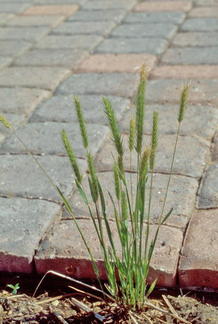 We mentioned this weed earlier in the year but it was too early to control it. Many people mistake little barley (Hordeum pusillum) for a little foxtail because the foxtail and little barley seedheads are similar. However, little barley is a winter annual that comes up in September - October and spends the winter as a small plant. It thrives in the cooler spring temperatures, forms seed heads and dies out usually by July. Foxtail, on the other hand, is a summer annual that does well in hot weather. Also, foxtail will not produce seedheads until mid- to late-summer. Now is the time to control little barley for next year. The best control for little barley is a thick lawn that is mowed high enough that sunlight does not hit the soil. Little barley seed will not germinate in such conditions. Overseeding now can thicken up a tall fescue lawn and prevent a little barley infestation. However, if you do not plan to overseed, preemergence herbicides can be used to provide at least partial control of this weed. The only preemergence herbicide that I know is labeled specifically for little barley is Surflan. It is also sold under the name of Weed Impede by Monterey Lawn and Garden. Surflan can only be used on warm-season grasses (bermudagrass, buffalograss, zoysiagrass) and tall fescue grown in warm-season areas such as Kansas. However, Dimension (dithiopyr), is labeled for barley (Herodium spp.) which would include little barley and therefore can be used to keep this weed under control. Because little barley is a winter annual, apply the preemergence herbicide now and water in to activate. If overseeding, do not apply any preemergence herbicide as it will interfere with the germination of tall fescue. (Ward Upham) 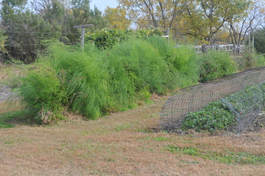 Harvest is long past but now is the time asparagus and rhubarb plants build up needed reserves for the next year. Be sure to water during dry weather and keep plants free of weeds. Do not fertilize until mid-March next year. Foliage should be left until all green is gone. It can then be removed or left for the winter to help collect snow. (Ward Upham) 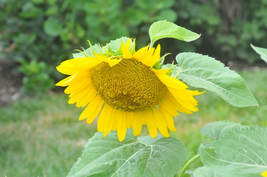 Sunflowers are usually ready to be harvested beginning in mid-September and into October. Seed heads can ripen on the plant, but they will need protection from birds. Try covering the heads with a paper sack or cheesecloth once the petals start turning brown. Use a twist tie or rubber band to secure the covering. This will not only help keep birds out but will prevent ripened seeds from dropping out of the head. Check for maturity by looking for the following signs: – Florets in the brown center of the flower disk should be shriveled. – Heads should have turned down. – The backside of the head should be lemon yellow. The ultimate check, of course, is to pull a few seeds to see if they have turned black with white stripes, the typical color. Empty shells usually indicate a lack of pollination earlier in the year. If heads are to remain uncovered, harvest when a few seeds start turning black and white. The flavor will not be good as when seeds are allowed to ripen on the plants, but fewer seeds will be lost. Cut the heads and place in a paper sack. Some people prefer to cut the heads with about a foot of stem attached and hang them upside down in a dry, well-ventilated area. A paper bag or cheesecloth can be placed over the heads to prevent seeds from dropping as they dry. Seeds can be easily removed from dry heads by rubbing gently. Roasting Seeds Raw, mature seeds may be prepared at home by covering unshelled seeds with salted water (2quarts of water to 1/4 to 2 cup salt). Bring to a boil and simmer 2 hours, or soak in the salt solution overnight. Drain and dry on absorbent paper. Put sunflower seeds in a shallow pan in a 300-degree F oven for 30 to 40 minutes or until golden brown, stirring occasionally. Take seeds out of the oven and add 1 teaspoon of melted butter or margarine, or cooking oil per 1 cup of seeds if they are to be eaten immediately. Stir to coat. Put on an absorbent towel. Salt to taste. (Ward Upham) 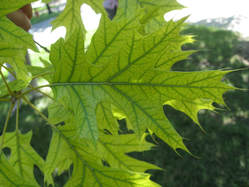 Have you applied fertilizer, but aren’t seeing any results? Soil pH might be the problem. Before we talk about why your plants can’t uptake essential nutrients, let’s talk about what pH is. Soil pH stands for potential Hydrogen and is measured on a 1-14 scale where 1 is very acidic, 7 is neutral, and 14 is very alkaline. “Building Soils for Better Crops” states that most agronomic crops prefer a soil pH ranging from 6 to 7.5, depending on the crop. Soil pH influences your plants’ ability to uptake nutrients. This is important because you might see symptoms of a nutrient deficiency, green veins and yellowing around the leaf, on your plant, but that doesn’t mean the nutrients are not in the soil. For example, in Kansas the micronutrient iron is plentiful in soils, yet we see iron chlorosis in plants, especially oak trees. This is because iron is in a soluble form and is easily taken up by oak trees when the soil pH ranges from 5.0 to 6.5, but when the soil pH is above a 7 iron is no longer soluble and the tree can’t use this micronutrient. Understanding soil pH when applying fertilizers, especially nitrogen, is important too because fertilizer has the potential raise or lower your soils pH. One of the best, and most accurate, ways to determine your soils pH is to send a soil sample to the K-State soil testing lab. Follow this link, https://bit.ly/2G17sYQ,for more information about soil testing. For more information about soil acidity and pH management, check out this video provided by the USDA, https://bit.ly/2LBluz8, and follow this link, https://bit.ly/2N180Bn, to Chapter 20 in “Building Soils for Better Crops” called Other Fertility Issues: Nutrients, CEC, Acidity, and Alkalinity. (Chandler Day) 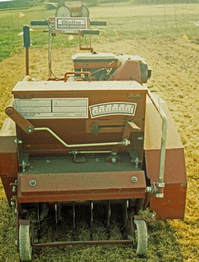 The keys to successful lawn seeding are proper rates, even dispersal, good seed to soil contact, and proper watering. Evenness is best achieved by carefully calibrating the seeder or by adjusting the seeder to a low setting and making several passes to ensure even distribution. Seeding a little on the heavy side with close overlapping is better than missing areas altogether, especially for the bunch-type tall fescue, which does not spread. Multiple seeder passes in opposite directions should help avoid this problem. A more serious error in seeding is using the improper rate. For tall fescue, aim for 6 to 8 pounds of seed per 1,000 square feet for new areas and about half as much for overseeding or seeding areas in the shade. Kentucky bluegrass is much smaller seed so less is needed for establishment. Use 2 to 3 pounds of seed per 1,000 square feet for a new lawn and half that for overseeding or shady areas. Using too much seed results in a lawn more prone to disease and damage from stress. The best way to avoid such a mistake is to determine the square footage of the yard first, and then calculate the amount of seed. Using too little seed can also be detrimental and result in clumpy turf that is not as visually pleasing. Establishing good seed to soil contact is essential for good germination rates. Slit seeders achieve good contact at the time of seeding by dropping seed directly behind the blade that slices a furrow into the soil. Packing wheels then follow to close the furrow. The same result can be accomplished by using a verticut before broadcasting the seed, and then verticutting a second time. Core aerators can also be used to seed grass. Go over an area at least three times in different directions, and then broadcast the seed. Germination will occur in the aeration holes. Because those holes stay moister than a traditional seedbed, this method requires less watering. If the soil that has been worked by a rototiller, fi rm the soil with a roller or lawn tractor and use light hand raking to mix the seed into the soil. A leaf rake often works better than a garden rake because it mixes seed more shallowly. Water newly planted areas lightly, but often. Keep soil constantly moist but not waterlogged. During hot days, a new lawn may need to be watered three times a day. If watered less, germination will be slowed. Cool, calm days may require watering only every couple of days. As the grass plants come up, gradually decrease watering to once a week if there is no rain. Let the plants tell you when to water. If you can push the blades down and they don't spring back up quickly, the lawn needs water. Once seed sprouts, try to minimize traffic (foot, mower, dog, etc.) seeded areas receive until the seedlings are a little more robust and ready to be mowed. Begin mowing once seedlings reach 3 to 4 inches tall. (Ward Upham) 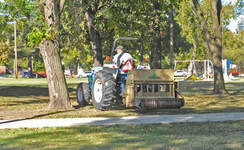 Tall fescue lawns that have become thin over the summer can be thickened up by overseeding during September. Start by mowing the grass short (1 to 1.5 inches) and removing the clippings. This will make it easier to achieve good seed-soil contact and increase the amount of light that will reach the young seedlings. Good seed-soil contact is vital if the overseeding is to be successful. Excess thatch can prevent seed from reaching the soil and germinating. Normally we want 1/4 inch of thatch or less when overseeding. If the thatch layer is 3/4 inch or more, it is usually easiest to use a sod cutter to remove it and start over with a new lawn. A power rake can be used to reduce a thatch layer that is less than 3/4 inch but more than a quarter inch. Once thatch is under control, the soil should be prepared for the seed. This can be done in various ways. For small spots, a hand rake can be used to roughen up the soil before the seed is applied. A verticut machine has solid vertical blades that can be set to cut furrows in the soil. It is best to go two different directions with the machine. A slit seeder is a verticut machine with a seed hopper added so the soil prep and seeding operation are combined. Another option is to use a core aerator. The core aerator will punch holes in the soil and deposit the soil cores on the surface of the ground. Each hole produces an excellent environment for seed germination and growth. Make three to four passes with the core aerator to ensure enough holes for the seed. Using a core aerator has the additional benefit of reducing the amount of watering needed to get the seed germinated and growing. Aeration also increases the water infiltration rate, decreases compaction, and increases the amount of oxygen in the soil. Of the three methods, I prefer the slit seeder for obtaining good seed/soil contact. However, if watering is difficult, core aeration may be a better option. Regardless of method used, fertilizer should be applied at the rate suggested by a soil test, or a starter fertilizer should be used at the rate suggested on the bag. (Ward Upham) 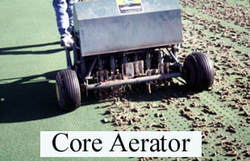 September is the optimum time to power rake or core-aerate tall fescue and Kentucky bluegrass lawns. These grasses should be coming out of their summer doldrums and beginning to grow more vigorously. This is a good time to consider what we are trying to accomplish with these practices. Power raking is primarily a thatch control operation. It can be excessively damaging to the turf if not done carefully. For lawns with one-half inch of thatch or less, I don’t recommend power raking but rather core aeration. For those who are unsure what thatch is, it is a springy layer of light-brown organic matter that resembles peat moss and is located above the soil but below the grass foliage. Power raking pulls up an incredible amount of material that then must be dealt with by composting or discarding. Core-aeration is a much better practice for most lawns. By removing cores of soil, core-aeration relieves compaction, hastens thatch decomposition, and improves water, nutrient, and oxygen movement into the soil profile. This operation should be performed when the soil is just moist enough so that it crumbles easily when worked between the fingers. Enough passes should be made so that the holes are spaced about 2 to 3 inches apart. Ideally, the holes should penetrate 2.5 to 3 inches deep. The cores can be left on the lawn to fall apart naturally (a process that usually takes two or three weeks, depending on soil-type), or they can be broken up with a power rake set just low enough to nick the cores, and then dragged with a section of chain-link fence or a steel doormat. The intermingling of soil and thatch is beneficial to the lawn. (Ward Upham) |
AuthorsCynthia Domenghini runs the Horticulture Response Center in the Department of Horticulture and Natural Resources at Kansas State University. Other contributors include K-State Extension Specialists. Archives
March 2024
Categories
All
|
| K-State Research and Extension Horticulture Newsletter |
|
 RSS Feed
RSS Feed
